Abstract
The effects of temperatures of 50 and 60 C on log-phase and stationary-phase cell suspensions of Staphylococcus aureus are described. There is a leakage of free amino acids, protein, and 260 mμ-absorbing material from both types of cell suspension, and membrane damage, as measured by the intracellular penetration of 8-anilino-1-naphthalene-sulfonic acid, may be partially related to this leakage. Ribonucleic acid (RNA) degradation at any one temperature is virtually the same for both types of cell suspension, proceeding initially at a more rapid rate at 60 C than at 50 C. However, at the lower temperature, there is a secondary breakdown of RNA, which may be the result of enzyme action on a particularly labile RNA fraction. With stationary-phase cell suspensions heated in 1 m sucrose, there is a more rapid degradation of RNA at 60 C than with cells in water. The results are discussed in relation to the biochemical effects of moist heat on the organism.
Full text
PDF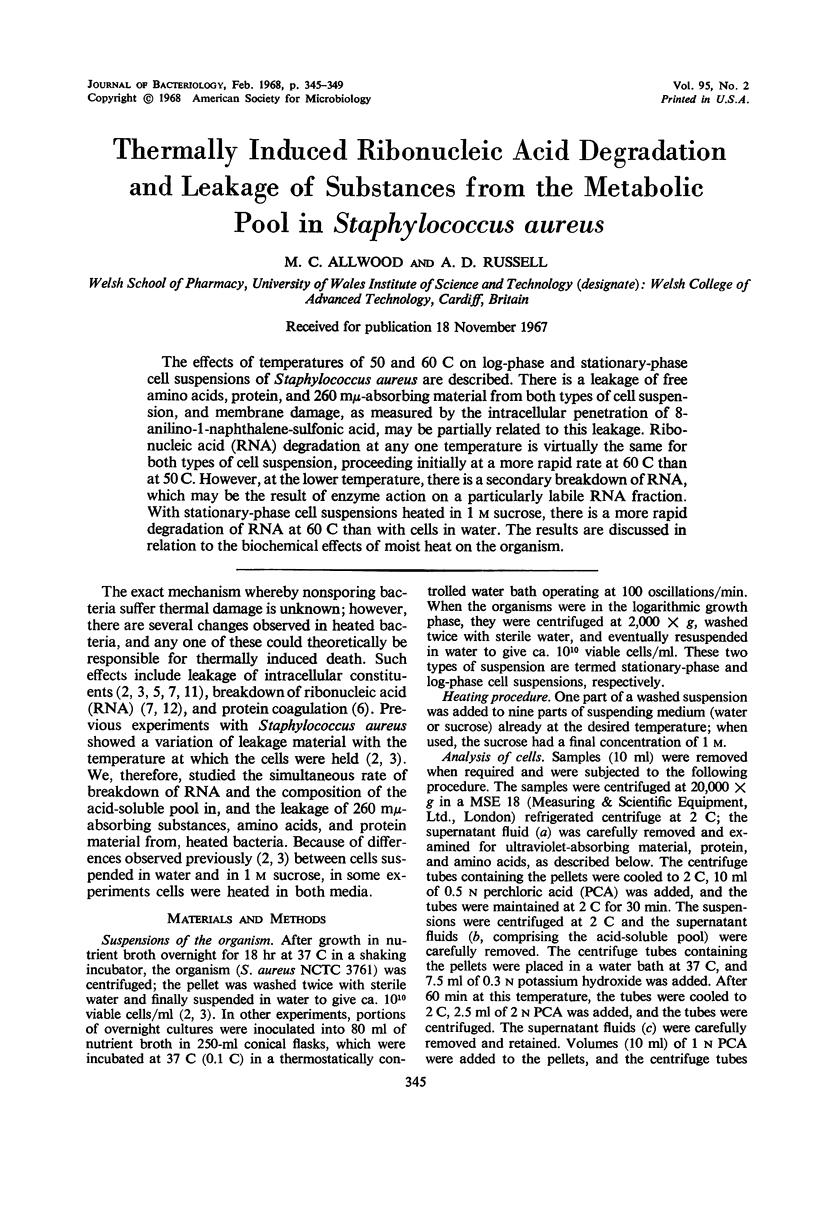
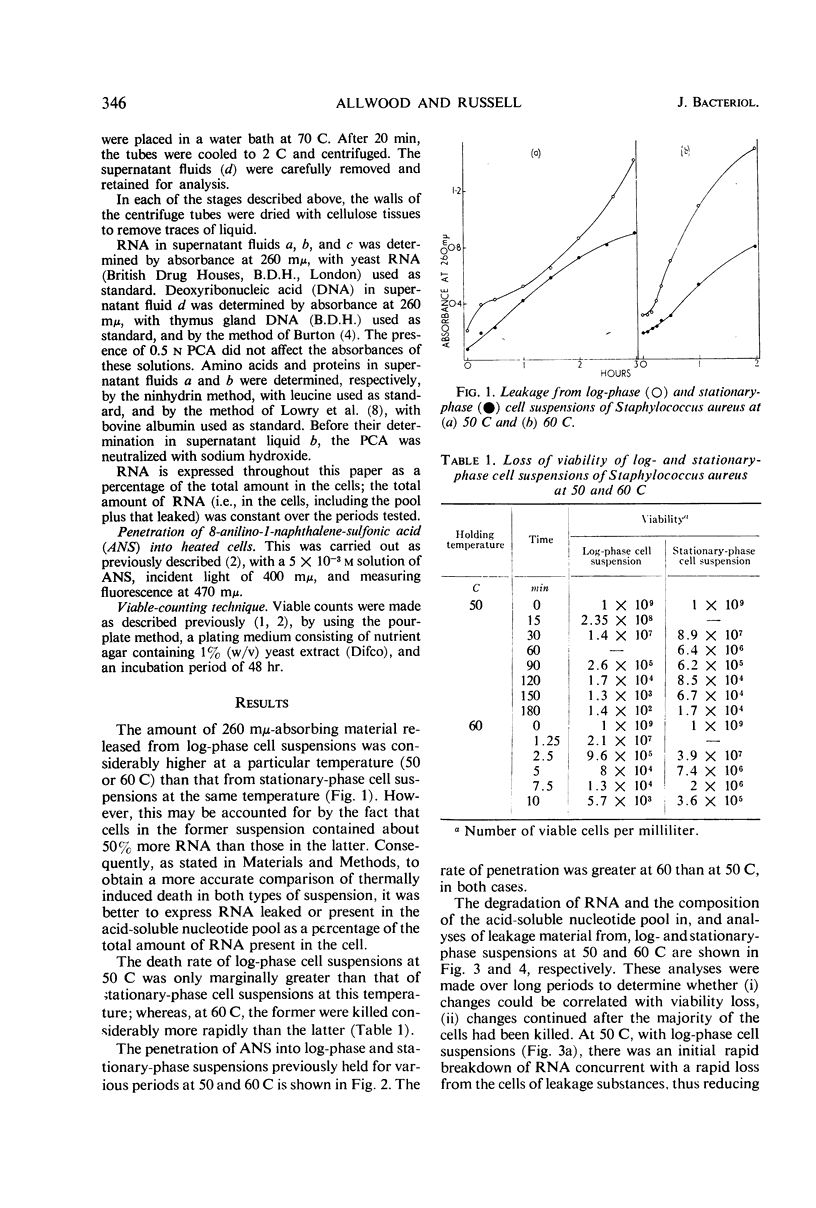
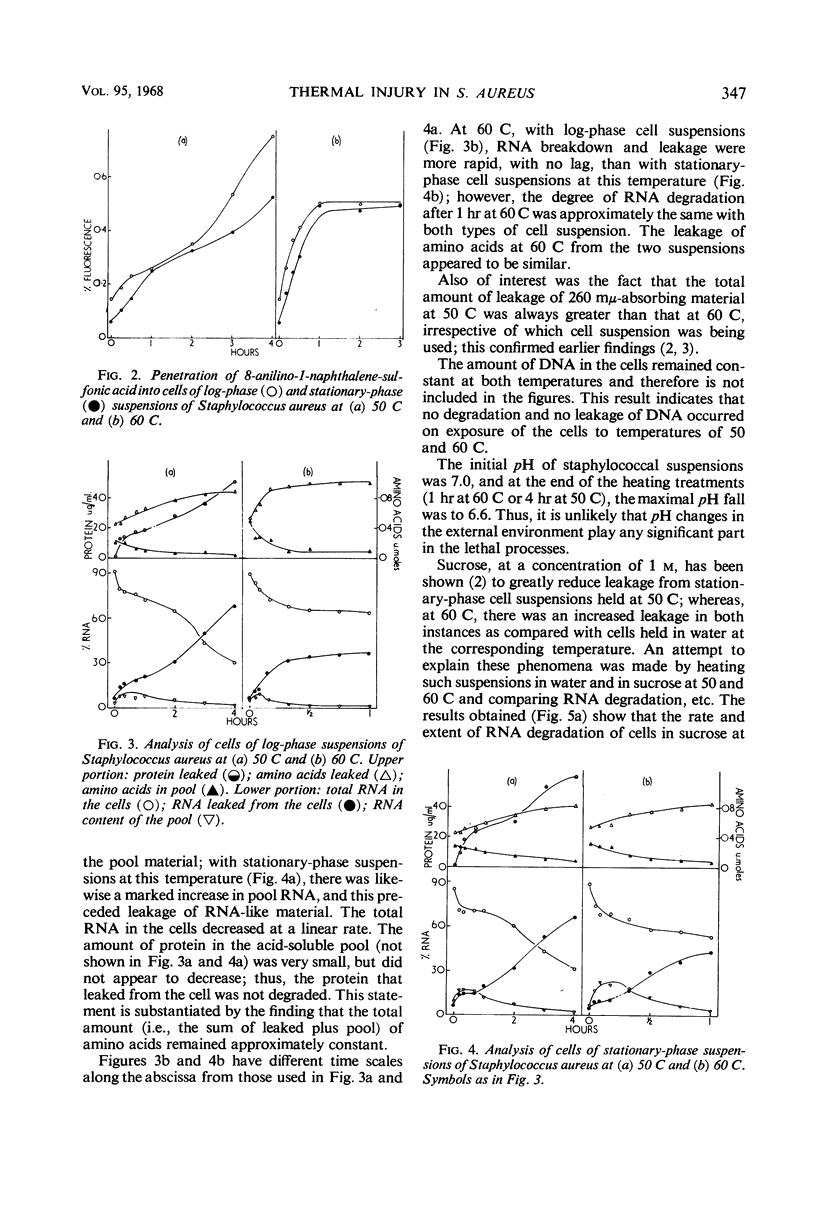
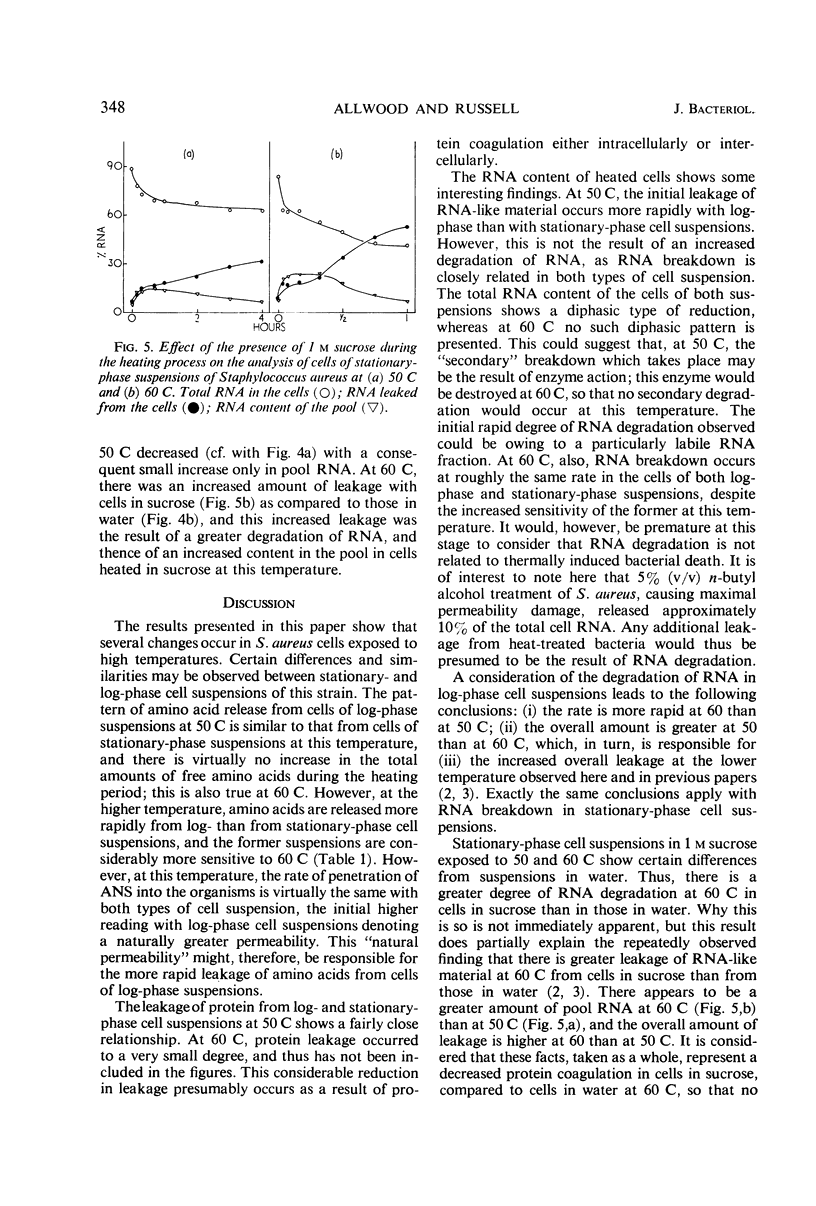
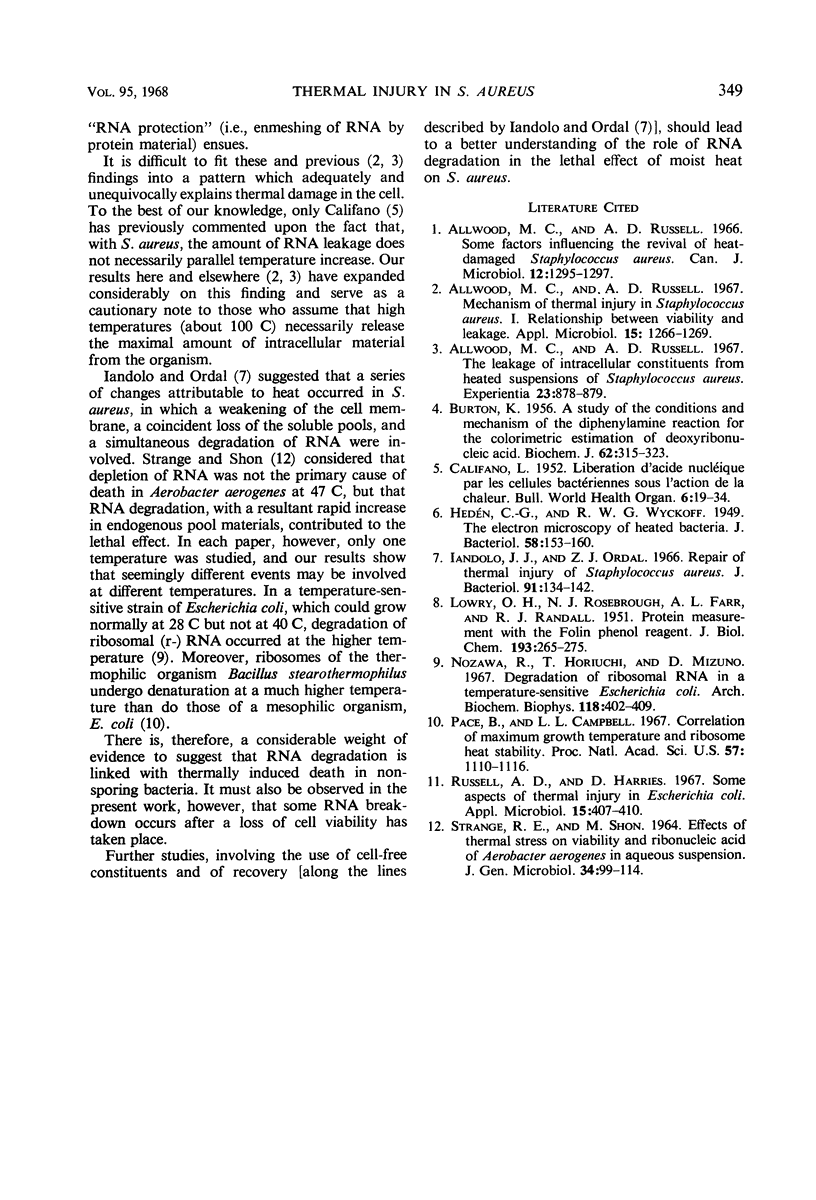
Selected References
These references are in PubMed. This may not be the complete list of references from this article.
- Allwood M. C., Russell A. D. Mechanism of Thermal Injury in Staphylococcus aureus: I. Relationship Between Viability and Leakage. Appl Microbiol. 1967 Nov;15(6):1266–1269. doi: 10.1128/am.15.6.1266-1269.1967. [DOI] [PMC free article] [PubMed] [Google Scholar]
- Allwood M. C., Russell A. D. Some factors influencing the revival of heat-damaged Staphylococcus aureus. Can J Microbiol. 1966 Dec;12(6):1295–1297. doi: 10.1139/m66-176. [DOI] [PubMed] [Google Scholar]
- Allwood M. C., Russell A. D. The leakage of intracellular constituents from heated suspensions of Staphylococcus aureus. Experientia. 1967 Oct 15;23(10):878–879. doi: 10.1007/BF02146908. [DOI] [PubMed] [Google Scholar]
- BURTON K. A study of the conditions and mechanism of the diphenylamine reaction for the colorimetric estimation of deoxyribonucleic acid. Biochem J. 1956 Feb;62(2):315–323. doi: 10.1042/bj0620315. [DOI] [PMC free article] [PubMed] [Google Scholar]
- CALIFANO L. Libération d'acide nucléique par les cellules bactériennes sous l'action de la chaleur. Bull World Health Organ. 1952;6(1-2):19–34. [PMC free article] [PubMed] [Google Scholar]
- Hedén C. G., Wyckoff R. W. THE ELECTRON MICROSCOPY OF HEATED BACTERIA. J Bacteriol. 1949 Aug;58(2):153–160. [PMC free article] [PubMed] [Google Scholar]
- Iandolo J. J., Ordal Z. J. Repair of thermal injury of Staphylococcus aureus. J Bacteriol. 1966 Jan;91(1):134–142. doi: 10.1128/jb.91.1.134-142.1966. [DOI] [PMC free article] [PubMed] [Google Scholar]
- LOWRY O. H., ROSEBROUGH N. J., FARR A. L., RANDALL R. J. Protein measurement with the Folin phenol reagent. J Biol Chem. 1951 Nov;193(1):265–275. [PubMed] [Google Scholar]
- Nozawa R., Horiuchi T., Mizuno D. Degradation of ribosomal RNA in a temperature-sensitive Escherichia coli. Arch Biochem Biophys. 1967 Feb;118(2):402–409. doi: 10.1016/0003-9861(67)90367-0. [DOI] [PubMed] [Google Scholar]
- Pace B., Campbell L. L. Correlation of maximal growth temperature and ribosome heat stability. Proc Natl Acad Sci U S A. 1967 Apr;57(4):1110–1116. doi: 10.1073/pnas.57.4.1110. [DOI] [PMC free article] [PubMed] [Google Scholar]
- Russell A. D., Harries D. Some aspects of thermal injury in Escherichia coli. Appl Microbiol. 1967 Mar;15(2):407–410. doi: 10.1128/am.15.2.407-410.1967. [DOI] [PMC free article] [PubMed] [Google Scholar]
- STRANGE R. E., SHON M. EFFECTS OF THERMAL STRESS ON VIABILITY AND RIBONUCLEIC ACID OF AEROBACTER AEROGENES IN AQUEOUS SUSPENSION. J Gen Microbiol. 1964 Jan;34:99–114. doi: 10.1099/00221287-34-1-99. [DOI] [PubMed] [Google Scholar]


